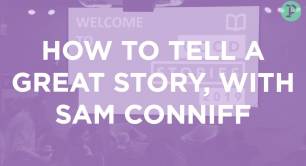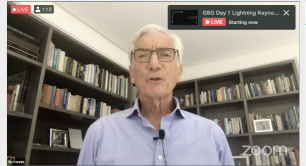Six things we’ve learned about creating a compelling impact narrative
The UN Sustainable Development Goals are the world’s roadmap to a more equitable and sustainable future. But the Goals are massively under-resourced by trillions of dollars. We can’t rely on governments alone to finance the SDGs, especially with the Covid-19 pandemic putting additional burden on public coffers.
Impact investing has the potential to draw in huge sums of financing from the private sector to benefit people and planet. But, as impact investing continues to gain traction, our movement does not speak with a unified voice about the impact opportunity. This reduces awareness, creates confusion and slows our momentum.
Our movement does not speak with a unified voice about the impact opportunity
Across the ecosystem we hear about how much time is spent explaining impact investing to leaders in government and financial institutions, instead of working on how to actually implement impact solutions. Imagine the possibilities if those same people already had a good grasp of the concept and fully understood the benefits of pursuing an impact agenda.
At the Global Steering Group for Impact Investment (GSG), we believe that having better and more consistent ways of telling our story will give added momentum for impact investing to truly go mainstream. So, earlier this year we worked with a group of 70 leaders in impact from around the world to help create a compelling narrative to convince governments and financial institutions to put their full weight behind impact investing. As part of this work, we’re launching the world’s first Impact Narrative Awards to celebrate exceptional storytelling in our space.
|
Have you found a compelling way to tell the story of impact investing? In 2021, GSG launched the world’s first Impact Narrative Awards with Torino Social Impact and Social Impact Agenda per l’Italia (the GSG national advisory board for Italy). Open to organisations of all kinds, the Impact Narrative Awards will celebrate exceptional storytelling in impact investing. They aim to identify best-in-class examples of impact investing stories used to persuade financial institutions and governments to put their full weight behind impact. The winners will be announced at the GSG Global Impact Summit (6-8 October) and will receive pro bono communication consultancy from Thinkshift, a specialty PR firm for mission-first enterprises. We invite you to apply (deadline 23 August) and to spread the word. |
In the meantime, here are six lessons we’ve learned through our work on creating a compelling impact narrative.
1. One size doesn’t fit all
Each country has its own unique history, culture, language and values. It's no surprise then that impact investing is developing differently depending on where you are in the world. Can we create one compelling narrative for everyone? Probably only partially. But we can provide guidance and tools to help countries better communicate with their own financial institutions and governments.
2. Keep it simple
There are already plenty of lengthy reports, frameworks, and information available about the “what”, “why” and “how” of impact investing. But to create a compelling narrative, we need concise and simple messages. It’s helpful to boil the message down to its most essential components. For those keen on delving deeper, we provide more nuance and detail as an option.
3. A picture is worth a thousand words
Some of the best storytelling is done through visuals, like “Earthrise”, a photo taken from space in 1968 which showed for the first time our earth’s striking fragility. Many argue it helped start the environmental movement. Combining images with words through the use of infographics can also be a powerful tool.
4. Build, test, refine. Repeat.
Rather than trying to come up with something perfect in isolation, our Impact Narrative Group first created something “good enough” that we could test with the impact ecosystem, then refined and tested it again until we had something we were happy with (more on this project below). This saves time in the long run and means we get to take into account plenty of feedback from stakeholders. It worked well for this project and we imagine it would also work well for those developing their own narrative content.
5. We need to find ways to cross the chasm
As the impact movement moves through the stages of Everett Rogers’ adoption curve (below), we must keep in mind that the messages that enticed innovators and early adopters are not going to be the same ones that convince the majority. Crossing the chasm between early adopters and the majority requires a new narrative capable of speaking to the greatest number.
6. Remember that our movement is young and still finding its feet
For those of us that have been in this space for a while, it’s easy to forget how young the movement is and how fast it has developed. Over the past 20 years, impact investing has grown from a few boutique firms experimenting with a limited number of strategies to the world’s largest financial institutions getting on board with a range of products. Do ESG and sustainable investing pose a threat to our movement or an opportunity for us to work with the mainstream to create even greater impact? What are the boundaries of impact investing? What are the different values of intentional impact investment as compared to impact measurement across all investments? One of the recurring challenges we’ve heard is how hard it is to simply explain impact investing to governments and financial institutions. Perhaps this is because our movement is young, trying to find its rightful place and, as such, is still changing.
We will be working with the impact investing movement on these bigger existential questions. But in the meantime, our Impact Narrative group has pulled together materials that we feel will be useful when working with financial institutions and governments.
The first iteration of the work (including best examples of narratives, definitions, practical frameworks, and more) will be released on the GSG website over the summer. Until then, we encourage you to submit your own top impact communication pieces through the Impact Narrative Awards.
- Daniel Rostrup leads the Impact Narrative project at the Global Steering Group for Impact Investment.
Photo: iStock / GeorgePeters
Thanks for reading Pioneers Post. As an entrepreneur or investor yourself, you'll know that producing quality work doesn't come free. We rely on our subscribers to sustain our journalism – so if you think it's worth having an independent, specialist media platform that covers social enterprise stories, please consider subscribing. You'll also be buying social: Pioneers Post is a social enterprise itself, reinvesting all our profits into helping you do good business, better.





